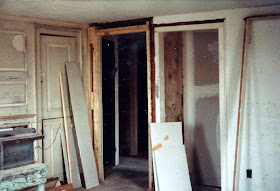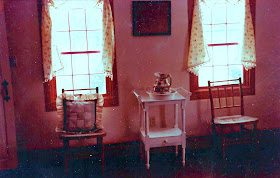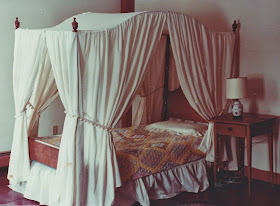THE

OLD HOUSE
AT
IPSWICH VILLAGE

SAVING MOSES JEWETT’S HOUSE
POST ROAD DEVELOPMENT CORPORATION
1981-1982
PART 7
PRUDENCE PAINE FISH
PART 7
PRUDENCE PAINE FISH
THE MASTER BEDCHAMBER
At the top of the stairs a turn to the left
brings you into the master bedchamber as it would have been called in the 18th
century. Here was a major problem.
As described previously the back staircase
had been removed leaving the front stairs the only way to access to the second
floor. The chimney in the middle
necessitated going through one of the two front rooms to get to a back room. This would not be an acceptable arrangement
for a late 20th century buyer.
To overcome this problem, an owner in the
distant past had found the easiest solution.
He divided the bedroom. Three
quarters of the space toward the gable end of the house became the bedroom reduced in size. The remaining quarter closest to the stairs
and chimney was partitioned off creating a corridor running from the front wall of the house to
the back rooms of the house. In this corridor
was hidden the paneled fireplace wall with bricked up fireplace and non-existent
hearth that should have been the main focus in a wonderful room. The paneling happened to be the best in the house.
 |
| On the left side not showing was the added in wall so what you see in the photo was the dark corridor from the door that you can see leading toward the rear second floor rooms. |
.
This wall would have to be
removed to restore the room to its original look. Now that there would be a new
back staircase there was no need for the offending corridor in which was found this beautiful and most sophisticated paneling of all.
 |
| The back of the this bedroom shows some of the paneling, a door to the back hall and bedrooms and a closet. The partition had been miraculously removed with hardly a mark on the ceiling or the floor. |
With great care Paul’s crew removed the
added wall without destroying the ceiling.
I didn’t think this could be done but it was. The entire ceiling was saved and the floor to
which the partition had been nailed was also brought back without damage.
 |
| Here is the paneled wall before restoration of the hearth and fireplace. This lovely wall had been previously hidden in a dark and narrow corridor |
The fireplace and hearth were restored and a
damper added.
 |
| Here is the same rear corner after being painted. |
The room was then painted a lovely blue, the
floor was painted and the room returned to its original look very carefully and
completely. What a beautiful room!
 |
| Looking toward the front of the house in the master bedchamber |
 |
| Unfortunately the colors are so distorted you would never know that this is a beautiful room with white walls and a Williamsburg blue on the woodwork. Tab curtains were made for the windows. |
THE GUEST ROOM
 |
| The second floor hall landing looking toward the second bedchamber. A little of the bedchamber blue is showing as is the "tusk" mixed by Nellie that worked so well. |
The room opposite the master bedchamber (designated
as the master bedchamber because it had the best paneling) was another room of
similar size. There were no special
issues to deal with here. There was a
lot of feather edged sheathing on the fireplace wall and two paneled doors at the
left of the fireplace opening two cupboards, one above the other.
The floor had particularly wide boards and the center had never been
painted. There was ancient linoleum and
the border around the linoleum had been painted many times. The floor was severely pitched away from the
chimney that was holding it up. It was slanting in the direction of the gable end of the house
where the sill had rotted. Leveling this floor would have been much too
invasive and would result in loss of plaster.
It was left alone hoping that antique buyers would understand and find
it acceptable. Lovers of old houses have to have a certain amount of tolerance
for the idiosyncrasies that go with an ancient building!
 |
| Like the parlor beneath this room there is an odd mix of feather edged sheathing combined with panels and nice paneled doors. |
The major problem we had with this room was
of our own making. I had seen a color I
particularly liked. It was a lovely rosy salmon color. I picked out a color and painted the
room. As it dried it got worse and
worse. We tried again. It was almost hot
pink! Oh! My gosh! Help! Again, Nellie reminded us, “Intensity increases with volume”. We should have heeded her advice. I thought
it was burned into our brains. We should have had her mix the paint! What looks like a nice color can be quite unsatisfactory when seen in large quantity on an entire room.
 |
| After many tried we succeeded in finding the color we wanted and it still looks nice. This photo may not be quite right but it is closer. |
 |
| The room was charming when we added some old pieces of furniture. The walls were actually white and the wood work was the color of the door opposite. |
We dubbed the room the “bubble gum room”
because no matter how hard we tried or how many times we repainted, it always
came out looking like bubble gum.
Searching for the right color I liked what
I saw on a chart for Old Village Paints.
This was a little different. We
had to purchase a can of brownish paint, then a can of off white and mix the
two together. Voila! A perfectly
wonderful, soft salmon emerged as this strange concoction was blended. On the
woodwork it looked even better. The
bubble gum room was finally history and a lovely, warm, cheerful room was a
sight for sore eyes. The bubble gum
nightmare was over but never forgotten.
Restoration of the hearth, fireplace and
installation of a damper completed the masonry work. A coat of paint on the floor and this room
was ready for a new owner.
To be continued in part 8. Just a little more to go!
To be continued in part 8. Just a little more to go!



I am enjoying each installment of this series, especially reliving all the restoration decisions based on the enviable amount of original material extant. The bedroom situation reminded me of an early Greek Revival house I considered buying in northern Ohio. The stairs ended with a small landing, and there were five bedrooms arranged in a ring, with only two of them exiting onto the landing, so the most remote room required passing through two other bedrooms. I wasn't in the house long enough to figure out what was original or how it could be fixed, but I imagine a back staircase like you (re)installed would have been part of the solution. (I can't recall any original features upstairs, but you should have seen the parlors!)
ReplyDelete--Jim
It's a dreary, rainy day in New England but your thoughtful comments cheered me up. An antique house with a chimney in the middle which so many of them had absolutely calls for a second staircase in the rear. Many of them were removed over the years and are left with an awkward floor plan. In fact, as we were putting this staircase back, another old house owner I knew was taking theirs out!
DeleteAs I await each installment of this series I grab a cup of coffee, click on your blog in the morning and I am always delighted to see a new entry. I particularly admire your approach to restoration an not remodeling an old structure. It is such a delicate balance that often goes astray as so many homes are destroyed by putting a modern new house inside and old frame.
ReplyDeleteHi Paula, I am so glad to hear you are enjoying this series. It seems as though it is going on forever! The serious old house people I guess are always interested. I do think it is really hard to find the right balance; keeping the house authentic but making it livable. I think it would be even harder today because of the expectations of the buying public especially in terms of bathrooms and kitchens.
DeleteAs always, thanks for chiming in!